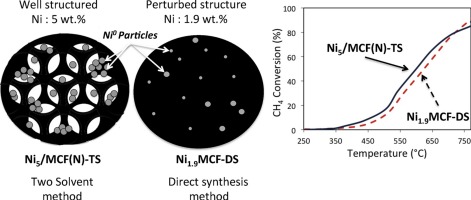Journal of CO2 Utilization ( IF 7.7 ) Pub Date : 2017-12-29 , DOI: 10.1016/j.jcou.2017.12.010 Oscar Daoura , Marie-Nour Kaydouh , Nissrine El-Hassan , Pascale Massiani , Franck Launay , Maya Boutros

|
Nickel-containing mesocellular silica foam (MCF) catalysts were prepared for dry reforming of methane (DRM). Different methods were used for the synthesis of the MCFs supports in order to enhance their surface areas and pore volumes. The incorporation of nickel was done by three different methods: incipient wetness impregnation, two-solvents post-synthesis method and direct one-pot synthesis introduction. All prepared materials were calcined then characterized by N2 sorption, X-Ray Diffraction (XRD), Transmission Electronic Microscopy (TEM), Temperature Programmed Reduction (TPR) and X-Ray Fluorescence (XRF). Their catalytic performances were tested in DRM between 200 and 770 °C, then for 4 h (stability test) at 650 °C, using a Gas Hourly Space Velocity (GHSV) of 36 L g−1 h−1 and an equimolar ratio of reactants. Promising results were obtained by using direct synthesis method (DS) in which small Ni particles in strong interaction with the support were formed.
中文翻译:

介孔二氧化硅泡沫基Ni催化剂,用于CH 4的干重整(通过CO 2)
制备了含镍的介孔二氧化硅泡沫(MCF)催化剂,用于甲烷的干重整(DRM)。为了增加MCFs载体的表面积和孔体积,使用了不同的方法来合成MCFs载体。镍的掺入是通过三种不同的方法完成的:初湿浸渍,两种溶剂的后合成方法和直接一锅法合成法。将所有制备的材料煅烧,然后通过N 2吸附,X射线衍射(XRD),透射电子显微镜(TEM),程序升温还原(TPR)和X射线荧光(XRF)进行表征。他们的催化性能在200至770 ° C的DRM中测试 ,然后在650 ° C进行4小时(稳定性测试) C,使用36 L g -1 h -1的气体时空速度(GHSV)和等摩尔比的反应物。通过使用直接合成法(DS)获得了令人鼓舞的结果,其中形成了与载体强烈相互作用的小Ni颗粒。


























 京公网安备 11010802027423号
京公网安备 11010802027423号